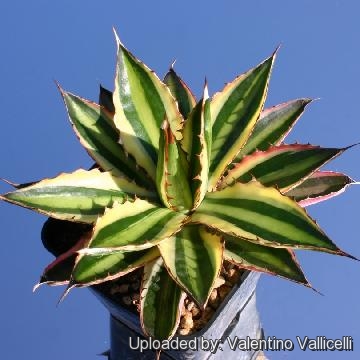
Agave lophantha ''quadricolor'' (Syn: Agave cv. GOSHIKIBANDAI)
Leaves have very nice 4 coloured bands. Large plants are extremely ornamental.
Origin and Habitat: Garden origin (Nursery produced cultivar)
Synonyms:
See all synonyms of Agave univittata
Description: Solitary or slowly clumping succulent rosette, up to 40 cm tall, 60 cm in diameter.
Leaves: Characteristically variegated with four distinct colours.
Subspecies, varieties, forms and cultivars of plants belonging to the Agave univittata group
- Agave lophantha var. pallida A.Berger: rosette 25—30-leaved, 50 to 55 cm in diameter. Leaves to 50 cm long, and 25 mm wide, pale green, darker towards the margins, margins with narrow, detaching horny lines, spines hooked, 2.5-5 cm apart, 8-10 mm long.
 Agave lophantha var. poselgeri (Salm-Dyck) A.Berger: has a free suckering habit and occurs in a variety of forms. Leaves only 20-26 cm long, 16—18 mm wide, sinuous, with a long, fine terminal spine, spines small, distant, absent in the upper part. Distribution: Mexico: Plateau near El Paso; Texas.
Agave lophantha var. poselgeri (Salm-Dyck) A.Berger: has a free suckering habit and occurs in a variety of forms. Leaves only 20-26 cm long, 16—18 mm wide, sinuous, with a long, fine terminal spine, spines small, distant, absent in the upper part. Distribution: Mexico: Plateau near El Paso; Texas.- Agave univittata Haw.: stemless, 30-60 cm tall, 50–100 cm wide, usually forming offsets. Leaves light green, with or without pale mid-stripe, marginal spines stout, curved downwards, terminal spine 25 mm long. It is extremely variable. Distribution: USA (Texas), Mexico (Coahuila, Nuevo Leon, Tamaulipas, San Luis Potosi, Veracruz, Puebla)
- Agave univittata var. angustifolia (A.Berger) H.Jacobsen: (Variegated form) Leaves not numerous, 75 cm long, 2.5 c. wide, terminal spine slender, leaf dark green on the upper side, more grey-green on the reverse, with numerous darker cross-lines, marginal spines small, 2—7 cm distant.
- Agave univittata var. brevifolia (Jacobi) H.Jacobsen: Leaves 32—33 cm long, 5 cm wide at the base, 3.5 cm wide above the centre, gradually tapering towards the tip, ending in a blunt tip, leaf colour without green longitudinal lines.
- Agave univittata var. coerulescens (Salm-Dyck) H.Jacobsen: Similar to the species; Leaves somewhat shorter and more numerous, rough, light blue-grey, without pale band, spines rather stout, directed downward.
- Agave univittata var. gracilior (Jacobi) H.Jacobsen: Rosette very regular. Leaves more numerous, slender, more narrow, leaf margins more light grey, spines much closer and with browned tip.
- Agave univittata var. latifolia (A.Berger) Breitung: has larger, very dense-leaved rosettes 130—150 cm in diameter, 75—100 cm high, forming offsets. Leaves sword-shaped, 73-76 cm long, below 5.5 cm, at the centre 6 cm wide.
 Agave univittata var. lophantha (Schiede ex Kunth) Maire & Weiller: Same as Agave univittata, and the two plants are not readily distinguishable.
Agave univittata var. lophantha (Schiede ex Kunth) Maire & Weiller: Same as Agave univittata, and the two plants are not readily distinguishable.  Agave univittata var. lophantha f. quadricolor: Solitary or slowly clumping succulent rosette, up to 40 cm tall, 60 cm in diameter. Leaves variegated with four distinct colours.
Agave univittata var. lophantha f. quadricolor: Solitary or slowly clumping succulent rosette, up to 40 cm tall, 60 cm in diameter. Leaves variegated with four distinct colours.- Agave univittata var. subcanescens (Jacobi) H.Jacobsen: Leaf margins and marginal spines almost white, leaf colour grey-green.
- Agave univittata var. tamaulipasana (A.Berger): Leaves 30-40 cm long, 25—35 mm wide, terminal spine conical, margins with a fine horny edge, marginal spines 15-20 mm apart, 3—7 mm. Distribution: Mexico, Taumalipas.
 Agave univittata var. lophantha f. quadricolor Photo by: Valentino Vallicelli
Agave univittata var. lophantha f. quadricolor Photo by: Valentino Vallicelli Agave univittata var. lophantha f. quadricolor Photo by: Viviana Alejandra Castro
Agave univittata var. lophantha f. quadricolor Photo by: Viviana Alejandra Castro Agave univittata var. lophantha f. quadricolor Photo by: Valentino Vallicelli
Agave univittata var. lophantha f. quadricolor Photo by: Valentino Vallicelli Agave univittata var. lophantha f. quadricolor Photo by: Cactus Art
Agave univittata var. lophantha f. quadricolor Photo by: Cactus Art Agave univittata var. lophantha f. quadricolor Photo by: Valentino Vallicelli
Agave univittata var. lophantha f. quadricolor Photo by: Valentino Vallicelli Agave univittata var. lophantha f. quadricolor Photo by: Cactus Art
Agave univittata var. lophantha f. quadricolor Photo by: Cactus Art Agave univittata var. lophantha f. quadricolor Photo by: Valentino Vallicelli
Agave univittata var. lophantha f. quadricolor Photo by: Valentino Vallicelli Agave univittata var. lophantha f. quadricolor Photo by: Valentino Vallicelli
Agave univittata var. lophantha f. quadricolor Photo by: Valentino VallicelliCultivation and Propagation: It is a relatively easy-to-grow species. If grown in a pot, it is a wonderful looking species.
Exposure: Suited for light shade to full sun, but better with some shade in summer. Plants cultivated outdoors are more drought tolerant and can take some heat and full sun.
Soil: It does great in containers or in the ground. It needs a very well-drained soil.
Water requirements: It grows fairly fast in summer if provided with copious water, but allow to dry thoroughly before watering again (the more water and fertilizer this plant gets, the faster it will grow). During the winter months, one should only water enough to keep the leaves from shrivelling.
Hardiness: It is frost tolerant to -5° C, but it is best to avoid freezing temperatures.
Maintenance: Remove suckers to show off the beauty and form of the individual rosette.
Propagation: By suckers, which often are found growing around the base of the plant, Remove the basal suckers (if available) in spring or summer and let the cuttings dry for a few days before inserting into compost.



















